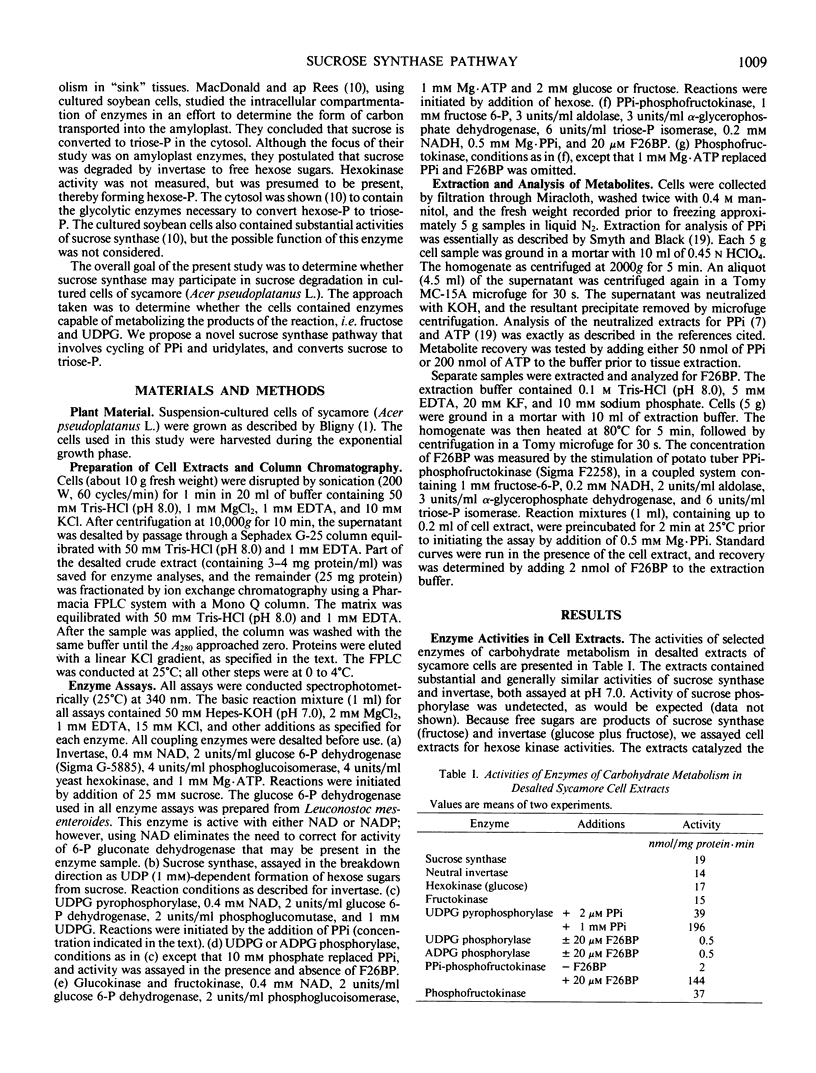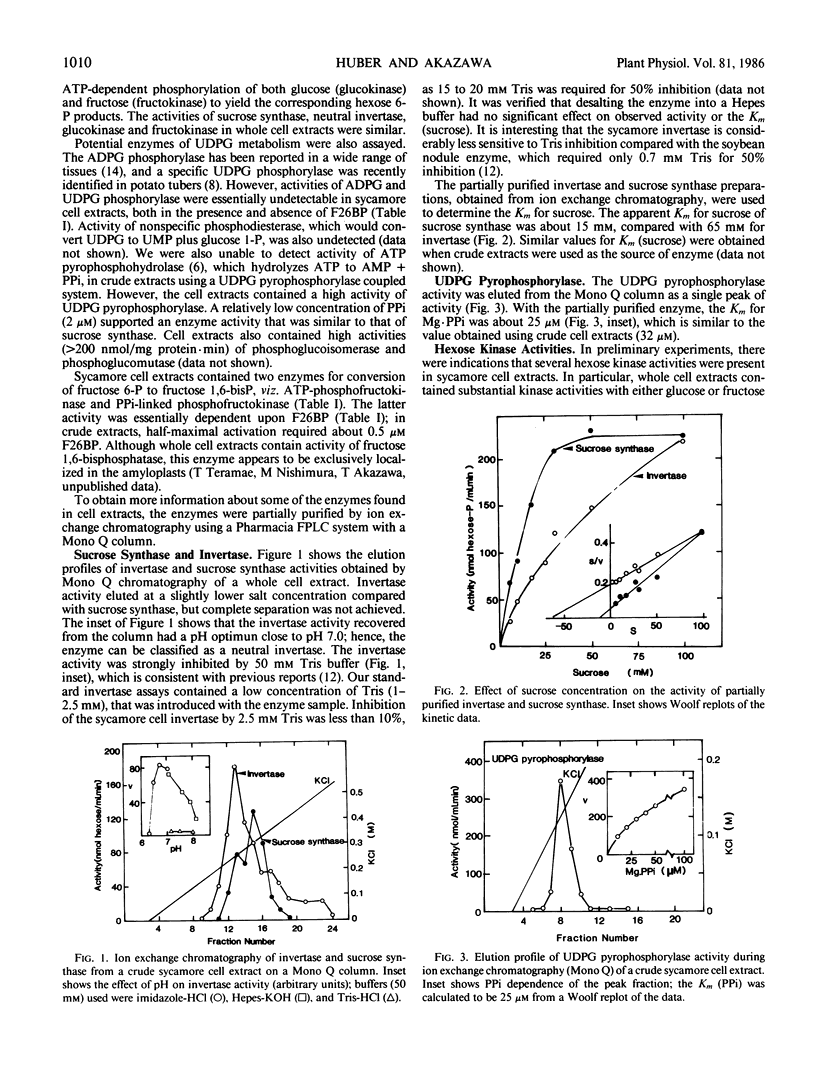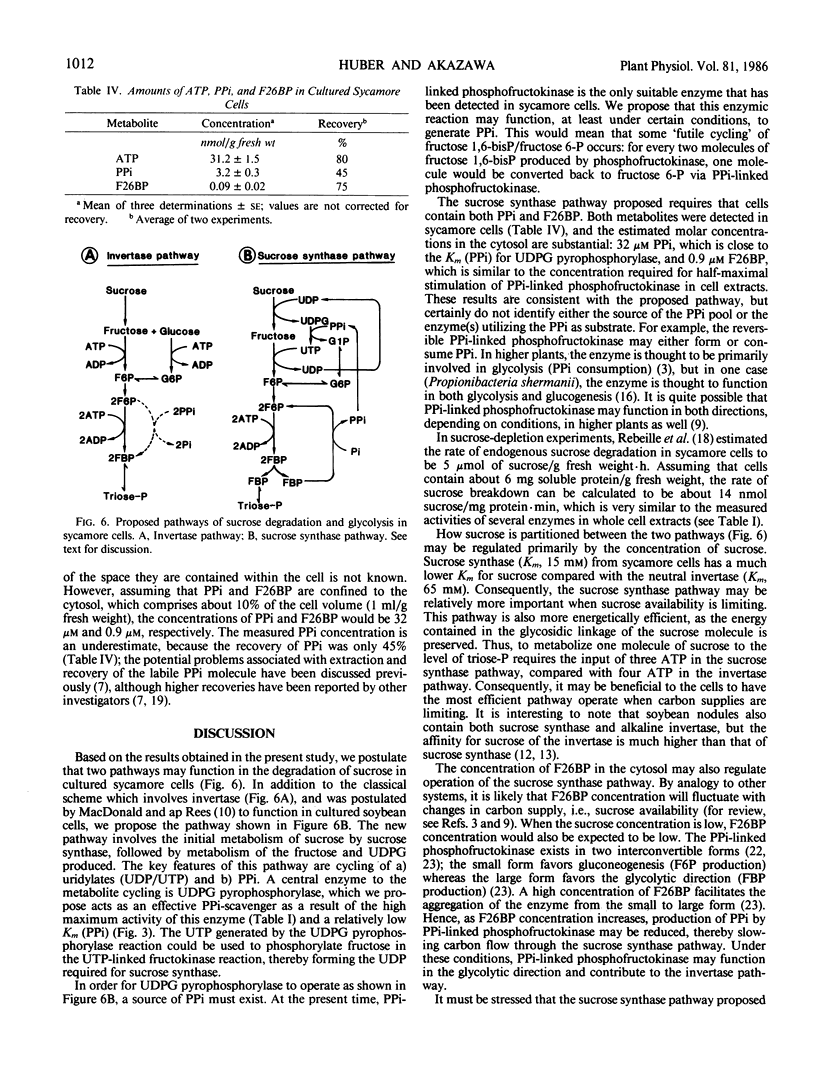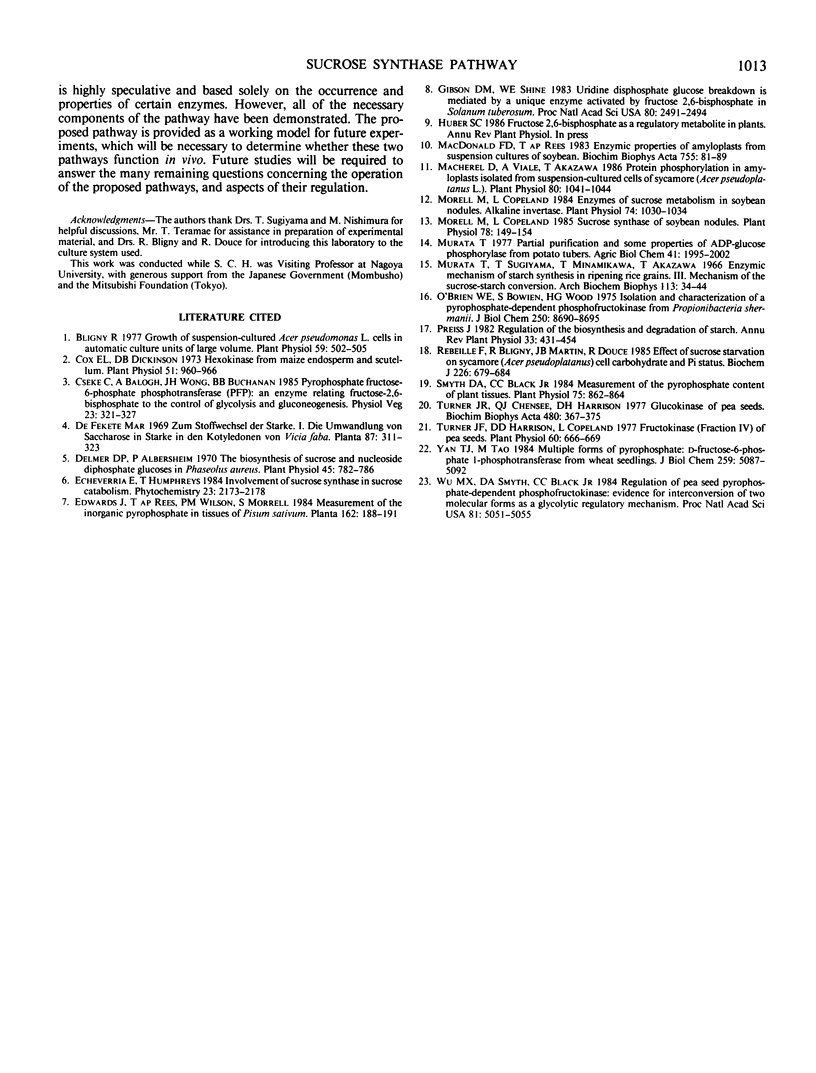Abstract
Enzymes of sucrose degradation and glycolysis in cultured sycamore (Acer pseudoplatanus L.) cells were assayed and characterized in crude extracts and after partial purification, in an attempt to identify pathways for sucrose catabolism. Desalted cell extracts contained similar activities (20-40 nanomoles per milligram protein per minute) of sucrose synthase, neutral invertase, glucokinase, fructokinase, phosphofructokinase, and UDPglucose pyrophosphorylase (assayed with 2 micromolar pyrophosphate (PPi). PPi-linked phosphofructokinase activity was virtually dependent upon fructose 2,6-bisphosphate, and the maximum activity exceeded that of ATP-linked phosphofructokinase. Hexokinase activity, with glucose as substrate, was highly specific for ATP, whereas fructokinase activity was relatively nonspecific. At 1 millimolar nucleoside triphosphate, fructokinase activity decreased in the order: UTP > ATP > CTP > GTP. We propose two pathways for sucrose degradation. One involves invertase action, followed by classical glycolysis of hexose sugars, and the other is a novel pathway initiated by sucrose synthase. The Km for sucrose of sucrose synthase was severalfold lower than that of neutral invertase (15 versus 65 millimolar), which may determine carbon partitioning between the two pathways. The sucrose synthase pathway proposed involves cycling of uridylates and PPi. UDPglucose pyrophosphorylase, which is shown to be an effective `PPi-scavenger,' would consume PPi and form UTP. The UTP could be then utilized in the UTP-linked fructokinase reaction, thereby forming UDP for sucrose synthase. The source of PPi is postulated to arise from the back reaction of PPi-linked phosphofructokinase. Sycamore cells contained a substantial endogenous pool of PPi (about 3 nanomoles per gram fresh weight, roughly 1/10 the amount of ATP in these cells), and sufficient fructose 2,6-bisphosphate (0.09 nanomole per gram fresh weight) to activate the PPi-linked phosphofructokinase. Possible regulation and energetic differences between the sucrose synthase and invertase pathways are discussed.
Full text
PDF





Selected References
These references are in PubMed. This may not be the complete list of references from this article.
- Bligny R. Growth of Suspension-cultured Acer pseudoplatanus L. Cells in Automatic Culture Units of Large Volume. Plant Physiol. 1977 Mar;59(3):502–505. doi: 10.1104/pp.59.3.502. [DOI] [PMC free article] [PubMed] [Google Scholar]
- Cox E. L., Dickinson D. B. Hexokinase from maize endosperm and scutellum. Plant Physiol. 1973 May;51(5):960–966. doi: 10.1104/pp.51.5.960. [DOI] [PMC free article] [PubMed] [Google Scholar]
- Delmer D. P., Albersheim P. The Biosynthesis of Sucrose and Nucleoside Diphosphate Glucoses in Phaseolus aureus. Plant Physiol. 1970 Jun;45(6):782–786. doi: 10.1104/pp.45.6.782. [DOI] [PMC free article] [PubMed] [Google Scholar]
- Gibson D. M., Shine W. E. Uridine diphosphate glucose breakdown is mediated by a unique enzyme activated by fructose 2,6-bisphosphate in Solanum tuberosum. Proc Natl Acad Sci U S A. 1983 May;80(9):2491–2494. doi: 10.1073/pnas.80.9.2491. [DOI] [PMC free article] [PubMed] [Google Scholar]
- Macherel D., Viale A., Akazawa T. Protein Phosphorylation in Amyloplasts Isolated from Suspension-Cultured Cells of Sycamore (Acer pseudoplatanus L.). Plant Physiol. 1986 Apr;80(4):1041–1044. doi: 10.1104/pp.80.4.1041. [DOI] [PMC free article] [PubMed] [Google Scholar]
- Morell M., Copeland L. Enzymes of sucrose breakdown in soybean nodules: alkaline invertase. Plant Physiol. 1984 Apr;74(4):1030–1034. doi: 10.1104/pp.74.4.1030. [DOI] [PMC free article] [PubMed] [Google Scholar]
- Morell M., Copeland L. Sucrose synthase of soybean nodules. Plant Physiol. 1985 May;78(1):149–154. doi: 10.1104/pp.78.1.149. [DOI] [PMC free article] [PubMed] [Google Scholar]
- Murata T., Sugiyama T., Minamikawa T., Akazawa T. Enzymic mechanism of starch synthesis in ripening rice grains. 3. Mechanism of the sucrose-starch conversion. Arch Biochem Biophys. 1966 Jan;113(1):34–44. doi: 10.1016/0003-9861(66)90153-6. [DOI] [PubMed] [Google Scholar]
- O'Brien W. E., Bowien S., Wood H. G. Isolation and characterization of a pyrophosphate-dependent phosphofructokinase from Propionibacterium shermanii. J Biol Chem. 1975 Nov 25;250(22):8690–8695. [PubMed] [Google Scholar]
- Rébeillé F., Bligny R., Martin J. B., Douce R. Effect of sucrose starvation on sycamore (Acer pseudoplatanus) cell carbohydrate and Pi status. Biochem J. 1985 Mar 15;226(3):679–684. doi: 10.1042/bj2260679. [DOI] [PMC free article] [PubMed] [Google Scholar]
- Smyth D. A., Black C. C. Measurement of the pyrophosphate content of plant tissues. Plant Physiol. 1984 Jul;75(3):862–864. doi: 10.1104/pp.75.3.862. [DOI] [PMC free article] [PubMed] [Google Scholar]
- Turner J. F., Chensee Q. J., Harrison D. D. Glucokinase of pea seeds. Biochim Biophys Acta. 1977 Feb 9;480(2):367–375. doi: 10.1016/0005-2744(77)90029-8. [DOI] [PubMed] [Google Scholar]
- Turner J. F., Harrison D. D., Copeland L. Fructokinase (Fraction IV) of Pea Seeds. Plant Physiol. 1977 Nov;60(5):666–669. doi: 10.1104/pp.60.5.666. [DOI] [PMC free article] [PubMed] [Google Scholar]
- Wu M. X., Smyth D. A., Black C. C. Regulation of pea seed pyrophosphate-dependent phosphofructokinase: Evidence for interconversion of two molecular forms as a glycolytic regulatory mechanism. Proc Natl Acad Sci U S A. 1984 Aug;81(16):5051–5055. doi: 10.1073/pnas.81.16.5051. [DOI] [PMC free article] [PubMed] [Google Scholar]
- Yan T. F., Tao M. Multiple forms of pyrophosphate:D-fructose-6-phosphate 1-phosphotransferase from wheat seedlings. Regulation by fructose 2,6-bisphosphate. J Biol Chem. 1984 Apr 25;259(8):5087–5092. [PubMed] [Google Scholar]


